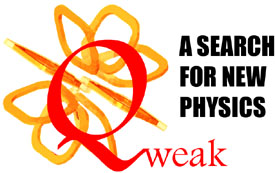General informations:
Research projects:
Ohio U. Insider

The Standard Model (SM) of electroweak interactions has been
confirmed with impressive precision in a variety of experiments,
ranging in energies from the eV scale in atomic parity violation to a
few hundred GeV in electron-positron collisions at LEP and the SLC.
Low-energy experiments continue to play an important role in testing
the SM, measuring its parameters, and in searching for possible
physics which may lie beyond the SM. Low-energy electroweak
observables are sensitive to new physics which does not sit on the
Z
0 resonance. A new approved
experiment, will use parity-violating
electron scattering from the proton at very low momentum transfers
(where strange quark effects will be small) to measure the ``weak
charge'' of the nucleon, Q
weak (the
vector coupling of the Z
0 to the
nucleon) to high precision. This experiment is tentatively scheduled for 2009. Our group has taken the responsability of preparing the data acquisition system of the experiment as well as the analysis program
The proton's weak charge
Q weak = 1 -
4 sin² W will be measured to a 4% precision using elastic ep
scattering
at Q² = 0.03 (GeV/c)² employing 180 µA of 80% polarized
beam on a 35 cm liquid hydrogen target. A dedicated high-acceptance
toroidal magnetic spectrometer will be constructed to detect the scattered
electrons.
W will be measured to a 4% precision using elastic ep
scattering
at Q² = 0.03 (GeV/c)² employing 180 µA of 80% polarized
beam on a 35 cm liquid hydrogen target. A dedicated high-acceptance
toroidal magnetic spectrometer will be constructed to detect the scattered
electrons.
The Standard Model makes a
firm prediction of Q weak, based on
the running of the weak mixing angle
from the Z0 pole down to low energies,
corresponding to a 10 sigma
effect in our experiment. Any significant deviation
from the
Standard Model prediction at low Q² would be a signal of new physics,
whereas agreement would place new and significant constraints on
possible Standard Model extensions, such as supersymmetry (SUSY).
Qweak WWW site
 The Standard Model (SM) of electroweak interactions has been
confirmed with impressive precision in a variety of experiments,
ranging in energies from the eV scale in atomic parity violation to a
few hundred GeV in electron-positron collisions at LEP and the SLC.
Low-energy experiments continue to play an important role in testing
the SM, measuring its parameters, and in searching for possible
physics which may lie beyond the SM. Low-energy electroweak
observables are sensitive to new physics which does not sit on the
Z0 resonance. A new approved
experiment, will use parity-violating
electron scattering from the proton at very low momentum transfers
(where strange quark effects will be small) to measure the ``weak
charge'' of the nucleon, Qweak (the
vector coupling of the Z0 to the
nucleon) to high precision. This experiment is tentatively scheduled for 2009. Our group has taken the responsability of preparing the data acquisition system of the experiment as well as the analysis program
The Standard Model (SM) of electroweak interactions has been
confirmed with impressive precision in a variety of experiments,
ranging in energies from the eV scale in atomic parity violation to a
few hundred GeV in electron-positron collisions at LEP and the SLC.
Low-energy experiments continue to play an important role in testing
the SM, measuring its parameters, and in searching for possible
physics which may lie beyond the SM. Low-energy electroweak
observables are sensitive to new physics which does not sit on the
Z0 resonance. A new approved
experiment, will use parity-violating
electron scattering from the proton at very low momentum transfers
(where strange quark effects will be small) to measure the ``weak
charge'' of the nucleon, Qweak (the
vector coupling of the Z0 to the
nucleon) to high precision. This experiment is tentatively scheduled for 2009. Our group has taken the responsability of preparing the data acquisition system of the experiment as well as the analysis program